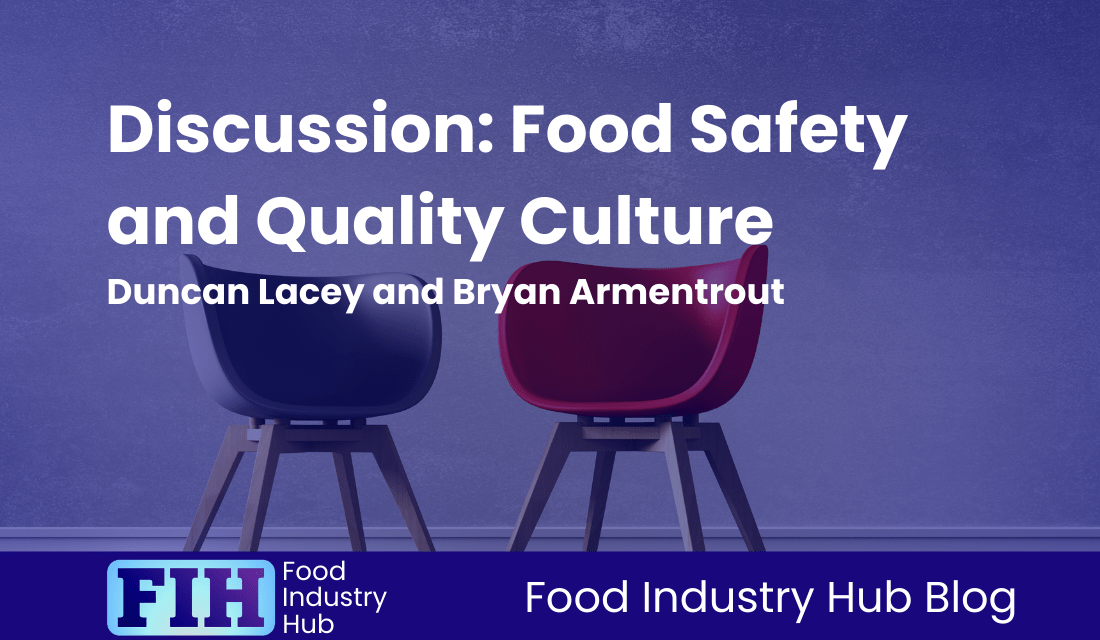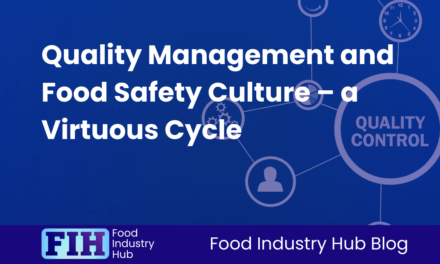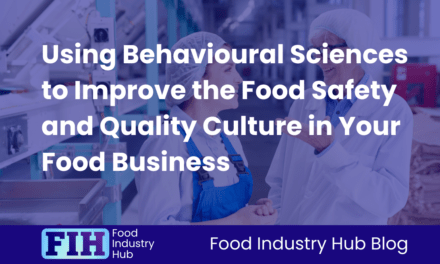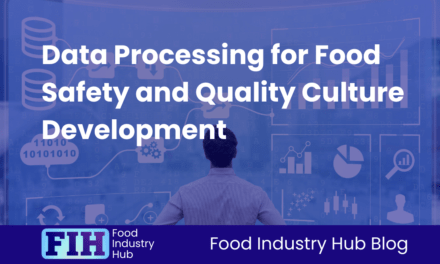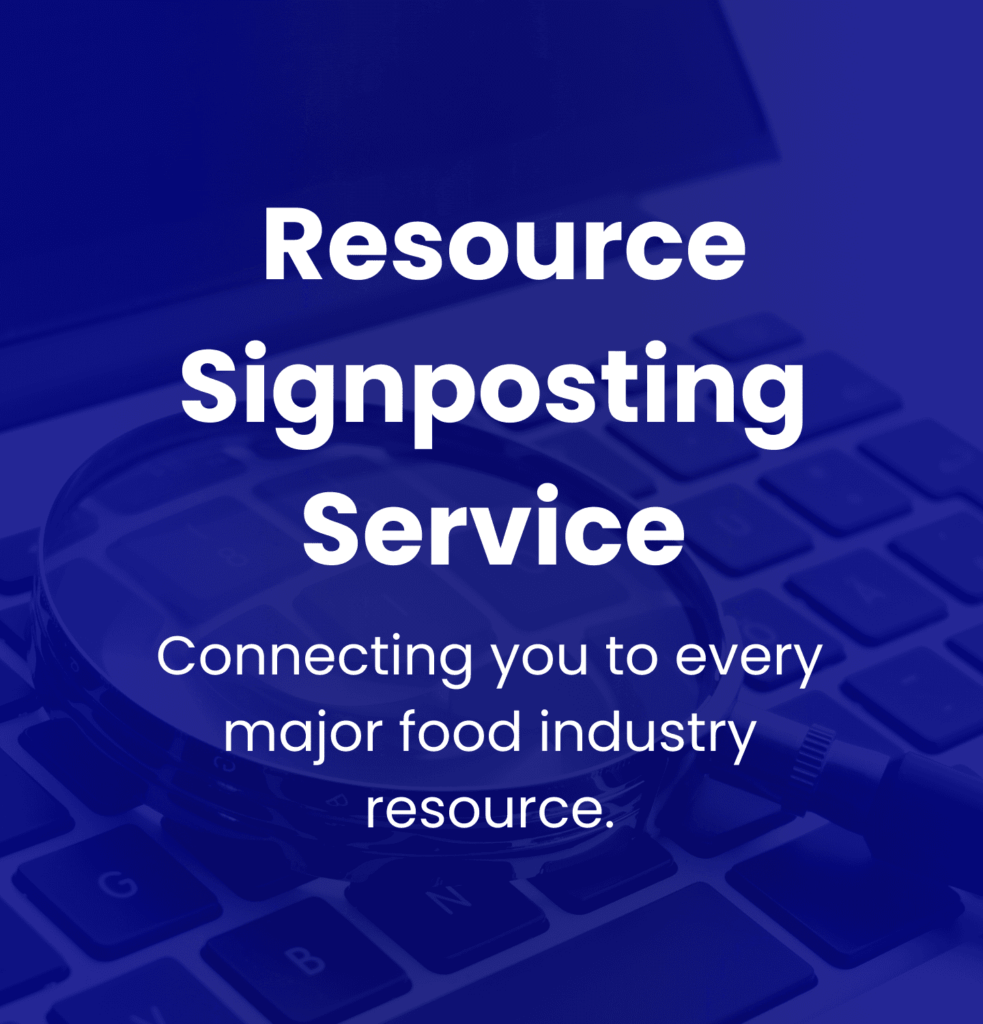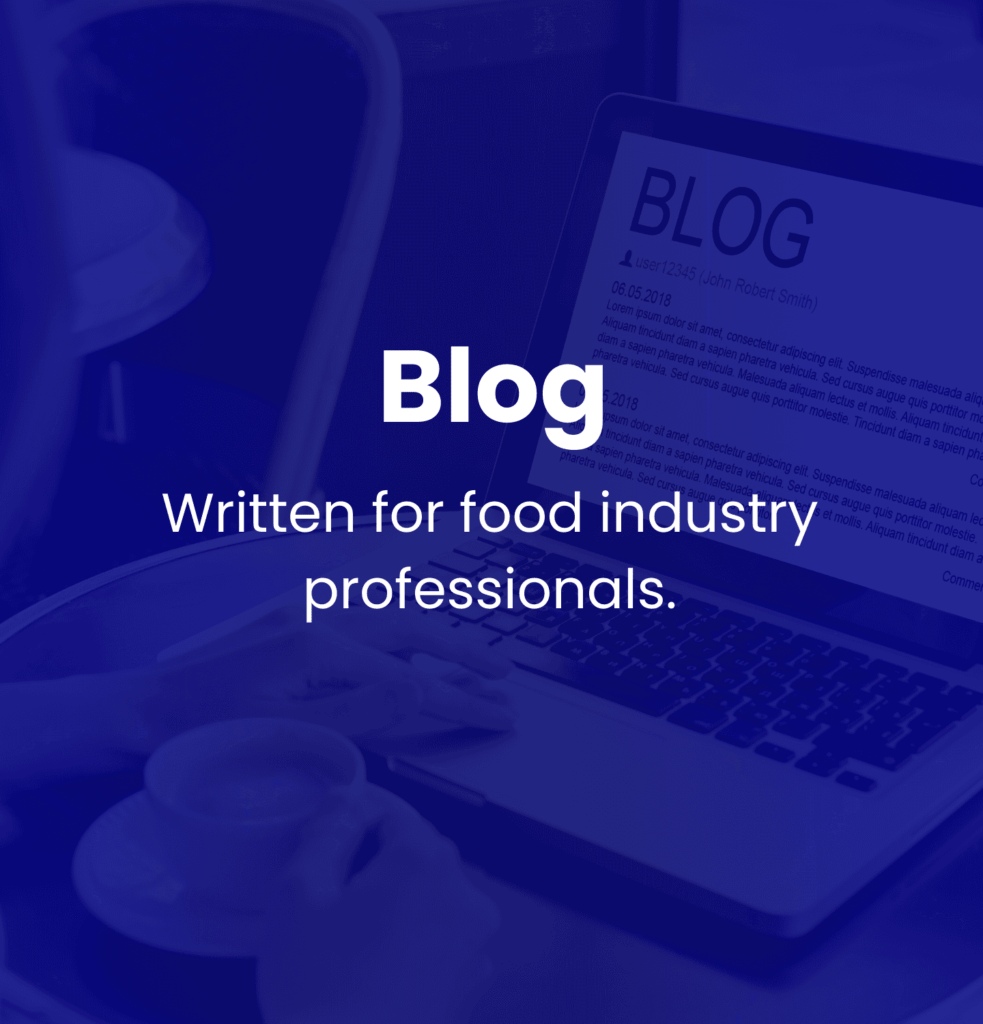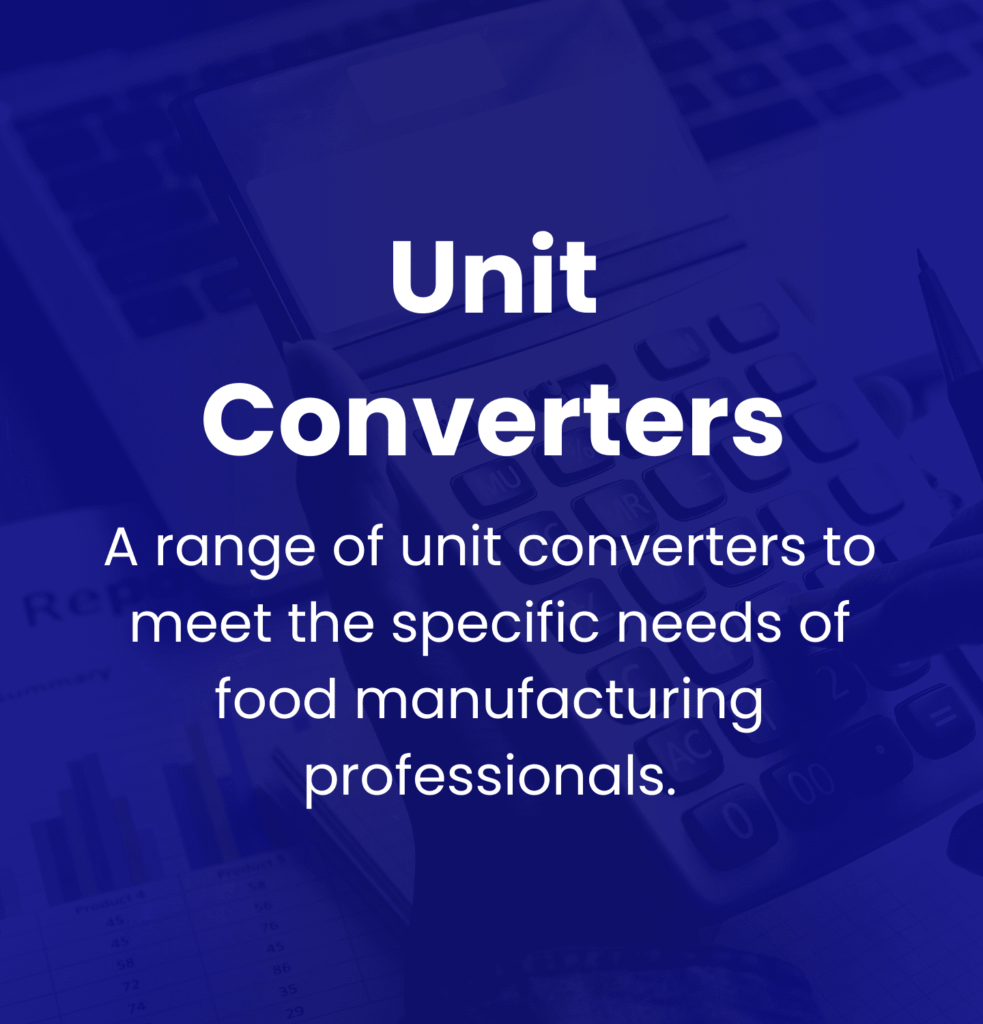Introduction
On Friday 30th August 2024, Food Industry Hub’s Duncan Lacey joined Bryan Armentrout on The Food Leadership Group Food Safety Chat Live! to discuss food safety and quality culture.
You can watch a recording of the chat here, and the transcript is shown below the video.
This post is part of a collection we’ve put together to explore the topic of food safety and quality culture, and you can explore the topic in more detail by browsing the related content.
Recording
Transcript
SPEAKERS
Duncan Lacey, Bryan Armentrout
Bryan Armentrout 00:01
And we are live, congratulations. You made it through the week, another week of fantastic food safety, amazing products, delicious meals for everyone, and a lot of times in what we do in food safety, everything goes unappreciated. So if you want some thank yous, we’re going to give them to you here today. So between myself and Duncan, thank you. We really appreciate all you do to make sure that what we eat is safe and wonderful. If you’re new to the chat, pull up a chair. This is the food safety chat, and every Friday at this time, so 8am Mountain Time, 3pm if you’re over on the other side of the pond, we bring on an amazing expert in food safety, and we have a chat. And if you’re new, one of the things that you’re going to notice is that this is not a stodgy presentation. This is not a bunch of PowerPoint slides. This is meant to be a conversation, and we do this for you. And the comments in here are what make this so much fun. So one of the things that we love to do, and I just referenced this a little bit here is we start off by saying where we’re at in the world. And this is really cool for today, because normally we have guests here in the US, and so we have a guest today who’s not. So I’ve had Australia in which is a little more difficult going the other direction, but I’m in Loveland, Colorado, Duncan, where it is currently, let’s see what is our temperature? We’re a lovely 58 degrees F, which, let’s see what is that? I always get these confused when you get in that range. So we’re sitting around 14 degrees. And where are you at, sir?
Duncan Lacey 01:34
So I’m in Warrington in England, and I think we’re in the region of 26 or 27 degrees C here, perfectly good and comfortable for me.
Bryan Armentrout 01:46
Absolutely love it. So as everybody’s filing in here, saying hello and let us know where you’re at in the world as well. So with the chat here, one of the things that we’re going to do with this is really cool, because Duncan, if you’re a regular here on the chat, is a major contributor to the chat, and his insights every week onto these different topics cover a broadband so it seems like whatever top topic we have Duncan, you know about it already, and you’ve got some really cool stuff to contribute. So sorry for embarrassing you, but you’re a great contributor, and I really appreciate so thanks for all you do to help this chat.
Duncan Lacey 02:24
It’s always fun to get involved.
Duncan Lacey 02:27
Thank you. And Tim, let’s see. So Tim somewhere in Southern Illinois, so it seems like, and this is always fun with Tim is on LinkedIn, if you, if you’re connected with Tim, number one, if you’re not connect with Tim, he’s amazing. And the guy’s a road warrior. He is always out, going visiting his customers, going to different conferences and such. And it seems like on Fridays, his chances of getting home on time are marginal at best. And so Tim, we’re wishing you the best of luck getting home for the family here on this Labor Day weekend, here in the US and Cori is in beautiful southern Tejas, so I’m sure it’s quite warm down there where Cori is as well. So with the chat, one of the things that we love to do here as well is everyone join us for a drink. So for Duncan, I doubt it’s coffee at this point of the day, but you never know.
Duncan Lacey 03:18
Today I’m drinking Vimto.
Bryan Armentrout 03:20
What is it?
Duncan Lacey 03:21
Vimto.
Bryan Armentrout 03:23
Vimto. Oh, gotcha nice
Duncan Lacey 03:25
It’s a soft drink.
Bryan Armentrout 03:29
Ah, wonderful. Got my coffee going here, so like it or hate it you’re getting the next thing here on the chat, and that’s the Friday dad joke. So Duncan go for it. For pirates, what is their favourite element?
Duncan Lacey 03:47
I don’t know. Bryan, what is a pirate’s favourite element?
Bryan Armentrout 03:51
Arrrrrgon!.
Duncan Lacey 03:53
Whoa, terrible. You should be ashamed.
Bryan Armentrout 03:59
I should be, I should be. Hello, hello. Anyone there? Yeah, yeah. I told that to my wife here with a chat, and she’s kind of rolled her eyes and took the dog out for a stroll. So
Duncan Lacey 04:13
The reaction we all hope for, I think
Bryan Armentrout 04:16
Maybe this is, this is a function of aging. So I think once you get to a certain age, those jokes become way funnier than they really are. No comment, no comment. So with the chat, one of the things that we love to do here is give our guests an opportunity to really kind of explain and give the audience a flavour for what you do. So Duncan food industry hub, what’s up with that? What’s What do you guys do?
Bryan Armentrout 04:45
Yeah, so I have a fairly long standing background working for food manufacturers and principally in quality systems, and at one point I realised that there’s quite a lot that I can do as an individual, but it will never scale as far as what a company can do. And so having a hand with database architecture and systems development, I’m now in a position of Director for Food Industry Hub, and you can think about it in two ways. So on the one hand, we’ve got a business to business software product that we provide to food manufacturers, and it helps with all sorts of things, from incident management, document control, supplier approval and raw material risk assessment. The other side of it is much more community focused. And so I used to get all of these requests from individuals looking for mentoring, guidance, information, advice. And I thought, let’s be honest about it, I simply can’t give everybody that one to one input. But what if there was a sort of impersonal brand that acted as a kind of mentor for everybody in the food industry. And so we’ve put together a really enormous library of resources that we signpost to a massive blog. There’s an email service just kind of it’s well worth checking out, and we get lots of enthusiastic and positive feedback.
Bryan Armentrout 06:24
Nice, nice. And if you’re not connected with Duncan on LinkedIn, you’re very active on there, so definitely connect with Duncan. I love seeing your posts on there. So yeah, it’s, it’s an interesting thing. And your experiences is mine as well. When you when you work in a company, you may have amazing insights and opportunities and systems that you put in place, but they kind of live just in that ecosphere. You can’t go out and necessarily provide that information to other companies. Generally, you don’t work for other companies, so you’re there to serve the needs of the company you’re at, and that information gets siloed, and that’s part of the reason why we do the chat here, and why I love what I do, and why you love what you do, is that we’re able to share these experiences and these learnings around food safety, because, as we say here, it’s not a point of competition. If we can help other companies reach new key insights, figure out new ways to do things and realise that this isn’t something that’s done on your own. This is something that you don’t have to struggle through these things, because the odds are someone’s already been through what you’re going through, and there is probably a better and easier way to do it than you’re struggling through. So Don’t, don’t struggle if you don’t have to.
Duncan Lacey 07:41
None of us should stand alone.
Bryan Armentrout 07:43
Yeah, but that’s part of I think you see this a lot, Duncan in companies quality people feel like we have to take everything on ourselves, and problems are presented and I have to fix it, and it ends up being a very, very stressful life. And don’t do that if you don’t have to for sure.
Duncan Lacey 08:03
So I think you know, whatever there’s a safety concern or a product quality concern, you kind of feel like you’re in a bit of a spotlight. And if you look at the ratio of the number of individuals a food manufacturer will employ into its engineering department or sales department compared to number of individuals in the quality department, it can feel disproportionate.
Bryan Armentrout 08:29
Yes, absolutely. And then they come to you and say, Wow, quality sure is costing us a lot of money in our budget. We need to figure out ways to reduce that. Dr DeFeo with the Duran Institute, who’s been on the show a few times, said, do a little experiment. Send your Quality Team home for a week and find out what happens, and then you’ll understand why that money is well spent. I was like, that is beautiful. I love that. And that’s part of what we talk about here in the chat at the beginning, is, if you’re good at what you do. Duncan, nobody notices because everything’s running smoothly.
Duncan Lacey 09:05
Yeah, it’s a hell of a value prop.
Bryan Armentrout 09:09
And so part of the fun part, and this kind of gets into our chat here for today of what we do, and I guess this just depends on your perspective, is in quality. We’re not necessarily siloed to our particular function. We get to go around and kind of stick our fingers into all kinds of different pies and play around in other people’s different worlds, because in our roles, we are system builders, and so we are looking at everything overall. So we get to step back in the company and look at that big picture and say, Is there a better way to do things? Is this the correct way to be doing things? Is this giving us the outputs that we’re looking for? Now granted, if you’re going around and bothering the maintenance people or things like this in these areas, at first, it may not be appreciated, but if you can show value in those areas, and you’re just not going in there and pointing your finger at them and saying, you have to do this. That never works, right? You have to partner with these groups. And I think that’s one of the key things that is a learning lesson for quality people. If you’re going to be successful, you have to collaborate.
Duncan Lacey 10:15
Well, the phrase is, persuade, incentivise, compel, in that order,
Bryan Armentrout 10:21
Yes, and that’s a great way to put it. And as Tayo says here, and I’m very sorry if I mispronounce your name, and she’s all the way in Lagos, Nigeria, this is, this is a nice way to say it, right. This quality should never be compromised. 100% agree. And with that, that definition of what does that mean? Can sometimes be lost. And that’s really kind of what we’re talking about today. Because really Duncan, there’s been a lot of chatter out there around food safety culture, and we talk about it here on the chat quite a bit. Because one of the lessons that I like to use this platform to hammer home is, if you’re very good at technical stuff, that’s great. That’s an important part of what we do. And when I was younger, I was a very, very good microbiologist, and I’m still very passionate about microbiology. However, the people side of things and the skill side of working with other people cannot be dismissed. It’s extremely important. You have to be able, and this is key, I think, is you have to be able to communicate technical information to non technical people, and that’s a skill set that’s often missing, isn’t it?
Duncan Lacey 10:26
I mean totally and with food safety and quality culture, I think it’s a difficult one, because so if you’re the quality manager or the technical manager, then you probably have a really solid grounding in things like supply approval and microbiology and KPI reporting, and then a few years ago, all of the compliance standards say, Okay, now in addition to that, you need to have a plan for the development of your Food Safety and Quality Culture. But there are absolutely nothing said on what it actually means or how to do it. So wearing a lot of hats and interacting with a lot of different people, it falls to the Quality Manager, because it’s traditionally, anything that’s in the standard falls to the Quality Manager. But, you know, I mean, if you can tell me what food safety and quality culture means, then that would be an interesting sort of a proposition to put forward.
Bryan Armentrout 12:39
Yeah, absolutely. And so that’s a kind of a perfect segue into what we wanted to talk about here today, because, yeah, this type of activity is placed on our desk, and it’s like, okay, go and go and figure it out. And I think, really, as we talk about here on the chat quite a bit, and Jose has done a great job of beating this into my head, is you have to start at the beginning, and you have to start with definitions, and you have to figure out what is it that you’re going after and when we’re preparing for this chat, Duncan, one of the things that you had said, and I picked up on this immediately, was, we talk a lot about food safety culture, but it’s also food quality culture, right? We’re forgetting that quality piece of it as well. And so let’s, let’s kind of think about this from a from a definition standpoint. So as you’re sitting down and thinking about these things, you know, so food safety culture and food quality culture. What do those two things mean to you?
Duncan Lacey 13:28
Okay, so if you, if you’ve looked at the definition that’s put forward by GFSI and BRCGS, they both say it’s the shared values and beliefs and behaviours that are expressed throughout a group. And I’m thinking, fine, that gets us partially the way there. And what I’m going to put forward is your food safety and quality culture, or, well, let’s start with culture is the organisational behaviour as a combination of individual behaviours and management decisions and how it expresses the values that the organisation holds. So one thing I think that if you’ve got values and ideals as the top level, and you might say, I value food safety, or I hold food quality to be an ideal, then it follows that you’re going to have a positive disposition toward food safety and quality, or you’ll have an attitude that leads you to have a positive stance to things that are going to promote food safety and quality and consequentially, your behaviours and actions will manifest those attitudes. So if the organisation starts by saying, these are our values. Then you get to challenge that by saying, Well, what sorts of attitudes and dispositions are reflected in, you know, management decisions and individual behaviours and group actions? And then it becomes a bit more substantive.
Bryan Armentrout 15:19
Yeah, and that’s and that’s the challenging part, isn’t it? Because something I always struggle with in companies is you’ll have your company mission statements and other things that they promote on their websites, and you’ll always have very vague, very nebulous terminology where they hit all the buzzwords right here at XYZ company, we believe in the values of the organisation and the earth and the planet and continuous improvement and serving our and you kind of trail off at that point because it does. It’s not actionable. And in addition to that, these different topics that we’re discussing here today mean different things to different people. So if I’m working in quality, using those framework terms that you’re we’re talking about here today, means something different to the procurement group, and I think that’s where a lot of the challenges come in, because different groups have different objectives in the organisation, and if they’re not aligned, that can cause tremendous stress. So for example, in that area, if the main objective of the procurement group is to buy stuff cheaply, that’s what you’re going to get, and they’re going to get their bonuses at the end of the year, and they’re going to get their raises, and they’re going to be happy, but the quality department is not going to be happy, because there’s failures in the plant, and there’s rejected loads, and all of these types of secondary fallout that occurs because of that. So when the company says, We want quality, what does that mean? And what I’ve seen Duncan is, and we’ll use this as a jumping point to the point you’re talking about is, I think a lot of times quality within a company becomes too insular. They look at it internally, but they’re not looking at it externally. One of the things that I always fight very hard for in companies is I don’t care, from a quality standpoint, technically, what the R&D group or the marketing group or things like this, think the product should be internally. What does the consumer think of our product, and a lot of times you get a disconnect.
Duncan Lacey 17:24
Well, you can actually, you can work around it much more systematically if you carry out a values analysis. So there’s two ways that organisations can establish the values, and one works and one doesn’t. The first one is you say to people on a scale of one to 10. How about how highly or lowly do you value quality? And everyone says, 10. You say, Okay, what scale of one to 10? Same thing for safely. And they go, these are, these are softball questions. Duncan, 10, okay. And what you end up with is 10 out of 10 across the board for anything that sounds good and virtuous. So it turns out to be fairly meaningless. The way that works is you say to people, we’ve got to have a ranking order. So if you were presented with a situation where you had to either short a customer order in the name of not dispatching defective quality product or dispatch defective product, and meet the order quantity which way are you going to fall on this? And you can get people to put their values in order relative to each other. Now, if you do that, then you get something that’s actually quite meaningful, and you can kind of proportionate and relative, and you can either have your senior management team state what the values that they want to be expressed throughout the organisation are and kind of publish it an internal memo or a policy document, or You can actually open it up and you say, interdepartmentally, let’s have open discussions, and say, what are the competing directives, and where are the conflicts arising, and how do we actually ideally want to resolve those so that there’s representation of every viewpoint in the way that we cascade values throughout the business. But that’s kind of the first necessary step, because if you, if you don’t take the time to define what your values are for a values analysis, then you can’t have a challenge whether or not behaviours and actions and management decisions are a reflection of those values.
Bryan Armentrout 19:40
Interesting that that’s a really good point. And this is what Courtland is talking about here, is figuring out how to measure these things. And I love the direction you’re going on this, so for example, we all know as you know human beings. Let’s say you go to a doctor’s appointment and you know, you try and be healthy. But you know, lots of times you don’t eat things that you should, and you have that nice pizza, or things like this, and you sit in the doctor’s office and your doctor runs through a series of questions with you to your example. Okay, Mr. Armentrout, do you exercise? Oh, yes, absolutely. I exercise all the time. Do you eat healthy? Oh, 100 you know, 100% after a while, the doctor’s figuring out that he’s not getting the real information. And so they’ll say, Okay, well, well, Bryan, how many drinks of alcohol do you have a week? Oh, well, I maybe have one or two in their minds. Now they’re taking that number and multiplying it by five and okay, well, yeah. And it’s a kind of sets up this false assurance associated with that. And your ranking system is a very clever way, because I like that. So your ranking system by department could be very revealing. So to my prior example, the quality department, how are they ranking things? How is the procurement department ranking things? And what are the disconnects between those two groups?
Duncan Lacey 20:58
Well, to actually measure performance against your values, you’ve got to come at it from the opposite angle. So you start off looking at behaviours and decisions, then you think, Well, what sort of attitudes and dispositions are implied by those behaviours and actions, and are those actions kind of reflective of the values that we hoped to live up to, and you can get seriously objective of this. So for example, if you think about non conformances that you raise internally, what’s the ratio of proactively generated non conformances as a result of things like internal audits and proactive escalations compared to reactive as a result of things like customer complaints and defects that you identify through analytical testing, and what you want is to have more proactive escalations than reactive. Alternatively, you might say things like, if you look at the internal audit schedule, are we taking management decisions that really prioritise adherence to the schedule, or are we consistently drifting and putting off the audits because we just think of it as a bit of a nuisance. So it gets in the way of the real job of whatever is it, you know, that kind of thing. So you can actually scrutinise organisational behaviour and what is implied from actions. And you know that I don’t take, you know, hand washing, I think is a very, very poor reflection. It’s not got anything valuable to tell us about food safety and quality culture. But just as an observation, it’s an easy thing for people to latch onto. So you make people make statements like, well, when we see people washing their hands, that’s the kind of behaviour that they would only buy into if they really valued Food Safety and Quality, and so by washing their hands, they’re demonstrating that they sincerely hold those values. And I’m thinking, Yeah, go on and fine, but you’re going to need to come up with something a lot more sophisticated than do people wash their hands if you want to assess cultural maturity.
Bryan Armentrout 23:27
Absolutely. And I think, yeah, so your example, I like where you’re going with this, also with your attitude and dispositions relative to those values. So to our doctor example, and this is something that I would build into my systems, is okay, fine. You’re saying that food safety and food quality are our highest priorities. How are you demonstrating those so to your example, Duncan, if it comes down to delaying an order, having an angry customer or shipping defective product, which of those two things are you’re going to do? And those are one of those decision trees in quality that I absolutely loathe is products on hold. It wasn’t manufactured correctly, and they would come to me and say, okay, Bryan, here’s our two choices associated with this. Do we ship the defective product, or do we short the customer? What would you like to do? And my response after time became, well, why did we make it in the first place? They’re trying to box you in and move that responsibility over to the quality group. Because a lot of times we’ll take it. The real answer is, why did this occur in the first place? Let’s figure that out. And one of the things that I would do, and I’m very curious to get your take on this, is, I would develop out actions in advance, so moving more toward that prevention of issues versus trying to correct after the fact is, okay, guys, let’s work through this scenario. Let’s say that we have exactly what you just talked about, and what is our decision going to be as a company? Well, we our values would indicate that that doesn’t ship, great. So when that actual decision point comes the decisions already made, right? It’s like, well, hold on a minute. Here. Are we changing our values now? We’ve already decided in advance that course of action isn’t the correct one. So why are we changing our minds now and being able to have that reflective approach to that? What are your thoughts around that?
Duncan Lacey 25:14
Well, with the do you ship it or not kind of debate? I think you should be able to have that decision fall out of your values analysis, and it should simply be a decision tree that says, if it doesn’t meet specification and QAS, then you kind of say, if it’s if it’s a red on a QAS, then you’re definitely not dispatching it. If it’s an amber, then you take a managerial decision and perhaps reach out to the customer and get customer authorisation, but that’s really in the event of an amber, but I think from a culture and values point of view, you kind of open the door to a few more interesting points. So if you’ve already, in advance, invested in assurance systems and preventative controls that avoid the defective product from being produced, then that upfront investment by itself, is an expression of values, and you can actually incorporate budget allocation into quality assurance processes as being a measure of managerial value. The other part of it is you can identify conflicts in your values system. So let’s imagine you’ve got an operator standing at the back end of a freezer tunnel, and there’s a load of defective product coming out, and it’s three o’clock in the morning, and the operator knows that if they divert the product into quarantine, so it goes on quality hold. The shift bonus is not going to get paid out for that shift because they fail to meet production targets and by definition, have produced out of spec product that had to go on quality hold. And the idea in those sorts of bonuses and incentive system is only produce good quality product and then you get your bonus, but it actually turns into a disincentive against taking quality control measures. So, you know, it can get quite complicated in the way you apply it.
Bryan Armentrout 27:26
Right. So you end up with this.
Duncan Lacey 27:29
It’s actually a manifestation of conflict in your internal value system. Because, yeah, when you try to align incentive systems, a lot of the time you can have that unintended consequence.
Bryan Armentrout 27:45
Exactly. And so the example that always comes to mind for me on this would be, yeah, let’s say that you have a machine operator in your scenario working on the night shift, producing product, and their machine, their filling machine, starts making a funny noise. And this operator is a veteran, then they know what the machine should sound like. They approach the supervisor and say, hey, you know, my machine sounds strange. I think something may be wrong to your point. The decision point at that time would be to Okay, well, we need to shut down and do a quick investigation to see what’s going on, pull in the quality group and what have you. If the supervisor goes, nah, nah, nah, keep running. I don’t care. The supervisor on the next shift, I don’t like anyway. We can let we can let him deal with it during his shift. Keep going. I’m not going to miss my target quota. The operator goes, Oh, okay. The chances of that operator bringing up that issue again to that supervisor are very small because they already know what the supervisor is going to say. So now, all of a sudden, defects start being created in your system that you’re not aware of until they cascade into a major failure.
Duncan Lacey 28:48
And that’s actually leaning to feedback and social compliance. Yeah. So that’s you know, the actions in isolation of a single supervisor might not be reflective of the total organisational values, but you actually, as people, we respond far more strongly to social feedback than to any other influence over our behaviour. So if you wanted to radically change somebody’s behavioural patterns, the best way of doing it is to kidnap that person, put them onto a desert island in a social group of people that they want to conform with, and you give them no option other than to kind of fall in line with that group. And people always will want to be accepted and conform and be embraced by the people that surround them. So even if you get that, there’s this principle to keep on running up against is you don’t need to be a senior manager to be a leader. And that is true in the sense that you have got social influence irrespective of your position on the hierarchy. But the backhanded, sort of double-edged sword that comes along with this is every single time I’ve ever heard the phrase applied, it’s been from a senior manager who wants everybody in the organisation to take a positive leadership role without any progression to accompany it. So it’s kind of a mixed bag.
Bryan Armentrout 30:35
That’s a really good point. Yeah, let’s explore that a little bit more. Because so for example, if I’m working on quality systems in a production facility, and I’m looking at, we’ll keep going with the filler example. So let’s say that there are, over the course of the different shifts in that production facility, there’s 20 people who are qualified to run that particular piece of machinery. What I will do, to your point, is, I’ll talk with that group and say, who are the leaders, who are the influencers? And I won’t ask that necessarily directly, but as you have a larger pool of people within a particular process, you have a pretty decent bell curve associated with that. You’ll have the average operators who can run them the machine with some guidance. You’re going to have a group in this particular example, let’s say two or three individuals who are fantastic at running that particular process, and then you have the other end of the curve of the people that are terrible at running that piece of equipment. And it always seems that the downtime and the issues occur are associated with their with their activities during their runs. You need to focus on the top three, and whatever they’re doing within that process, utilise their skills and their influence within their peer group to run that piece of machinery the same throughout that group. So your goal is to take that information from the top three and transfer it to the rest of that group. And you’re doing that to your point, Duncan, in my view, through peer influence. It’s not me coming in and dictating as the quality person. It’s like, okay, guys, let’s figure out the best way to run this piece of machinery, and let’s talk about it. And what do we do if we have a deviation associated with that and then building that into the processes. What do you think of that?
Duncan Lacey 32:19
So one of the problems that you run into is the most socially influential group and the most competent group are often starkly divorced from each other. So, you know. So this is a thought I only just had. But every factory environment I’ve been in, I would say it seems to take two distinct types of people. And when I’ve seen people that are really excellent, diligent operators, who really embody ownership, that’s often not that they’re often not the most socially influential on the shift. So you need to be quite careful when you’re talking about you need to take the top three. Which top three are you referring to?
Bryan Armentrout 33:15
That’s so I’m referring to the top three from their viewpoint, not my viewpoint. And then you can back that up with data. You can look at the compliance rates associated with that. But to your point, and that’s a very good one. Duncan, thanks for bringing that up. Is it’s exactly the same in what we do in quality. The most technical people are not necessarily the leaders.
Duncan Lacey 33:37
Well, you know, I’m thinking as well about the GFSI guidance document on quality, and it’s got all of these pillars, and it’s talking about leadership influence, culture, inclusivity, then you’ve got interactions with the quality system, then technical authority and that kind of stuff. And what I like about it is it identifies differentiated influencers that will act on the overall company culture. But what I think it fails to take into account is that hierarchy from values and ideals through attitudes and dispositions that cascade down into behaviours, actions and decisions. But if you were to say, look, we do the values analysis, we establish what sorts of values we want to be the guiding principles that shape our actions, then how do we actually encourage and reinforce that? And I’m thinking, yeah, you take your social influencers and you try to get them to lead the charge on peer pressure and reinforcement. Then you look at your quality management system and what sort of in marketing you’ve got, what’s called touch points. So you know, if I was going to do an advertising campaign, every time you see a television advert, that’s a touch point. Every time you see an advert in a magazine, touch point, product placement, touch point. And I’m thinking, let’s imagine you apply these principles in a factory. So you’ve got a record sheet that people are filling out. Well there’s an opportunity for a touch point that reinforces Food Safety and Quality ideals. Same with the poster on entrance to the factory and talk about artifacts, but from a marketing point of view, these are touch points, and they can with repetition, you can reinforce values and beliefs. Then, if you’ve got legitimate authority from managers, then that there’s absolutely no doubt about it, as it does carry sway and influence, even if it’s not always necessarily the most heavily weighted cultural influence. You take all of these things in concert, and you can have a feedback mechanism that kind of gradually shapes and reinforces and steers the way culture, you know, is applied throughout the organisation, but all of that should be a secondary process. So you need to first look at values and ideals and attitudes and dispositions and what sorts of behaviours would manifest themselves ideally, and then think about, well, how do we influence and shape it and guide it?
Bryan Armentrout 36:25
Yeah, exactly. Fantastic comments coming here. So Duncan, we definitely have people thinking about this, which is awesome. So Jill put up here, leadership and food safety are two different skill sets, and until technical experts prioritise and value leadership skills, won’t these challenges continue? Good question, what do you think Duncan?
Duncan Lacey 36:42
So on the basis that it always falls to the Quality Manager, 100% and it’s a completely different skill set, so we said at the front end of the conversation, if you’ve got a background in supplier approval and microbiology and all of this sort of stuff, you’re sort of scrounging in the dark for what on earth to be thinking about when it comes to food safety and quality culture. Because I used to, you know, it’s sort of funny to think you’d be far better off giving it to the marketing department than the quality department. Right now, if I want you to buy a Mercedes Benz, it’s not the quality guy, it’s not the engineer that built the car that’s going to persuade you to buy it. It’s the marketing department is going to instil in you a sense of desire or aspiration it’s going to convince you that you’ve got an unsatisfied need. And you know more than that, it’s not even that you need the Mercedes Benz. It’s an aspirational reach, that you’re the sort of person who deserves a Mercedes Benz, and you’re going to look really cool and you know, so it’s a marketing function that actually persuades and disseminates values and beliefs. So right from the beginning, we’d have been far better off giving food safety and quality culture improvement to the marketing department than the quality department.
Bryan Armentrout 38:23
Yeah, it’s a good point. So marketing to build on your example, because I think it’s a fantastic one. So, so you’re watching the television, and there’s a Mercedes Benz driving by the ocean on a beautiful drive, and there’s a wonderful woman on your arm as you’re driving, and the wind is blowing in your hair and you’re smiling. Mercedes Benz is not saying our vehicles met technical specifications 95% of the time. No, they’re selling the feeling and the joy of owning a Mercedes Benz versus another car.
Duncan Lacey 38:59
So if you want somebody to embrace food safety and quality ideals. There’s no point really in saying it’s got to meet that QAS. But you can say things like, listen when your dear old mum goes to the supermarket and buys her favourite cake, takes it home and enjoys a slice you don’t want there to be like a metal screw in it, because that would cause You know, this could affect your family member, your loved ones. It could be you on a receiving end of this. And then all of a sudden, people are invested because the narrative surrounding the actual values and ideals have shifted away from this is a compliance function as a spec to be met through to you could be personally affected. You should be personally invested, right? But it’s a completely different sort of a framing.
Bryan Armentrout 39:59
Hmm, and yeah, it’s, it’s something that’s a really interesting point to explore, is, how do we convey those values? So, to Courtland’s point here, and so he spoke the word Ferrari, but you would think, as the more money, and if I’m, if I’m missing your point here, Courtland, please elaborate. Is Ferrari’s are extraordinarily expensive, you would expect extremely high quality and reliability, and no not necessarily. Ferraris are known for especially particular models, for having lots of mechanical issues, and they’re always in the shop, and you need to get them worked on. But you’re not buying that. You’re buying the feeling of owning a Ferrari. I’ve worked my life. I’ve worked very hard, and now I’m going to reward myself with a Ferrari, and I’m willing to put additional money into that car to maintain that, that lifestyle and that feeling that I aspire to.
Duncan Lacey 40:53
And I know we’re sort of labouring the example at this point, but if you want to…
Bryan Armentrout 40:55
I think this is good, because we don’t think about this in quality. We don’t we’re technical people, right? I think it’s very important to build on this. So please, yes. Let’s
Duncan Lacey 41:06
Say you’ve got two car buyers, and one of them is a mom with three children, and what she’s really concerned about is fuel efficiency, safety and what the insurance premiums are going to be. And conversely, you’ve got a 23 year old millionaire guy, and he’s concerned about how cool am I going to look in this? How exciting is it going to feel on track days? And what am I going to look like curb side? And both of those two needs are felt differently and need to be appealed to differently, and the type of product that you’re putting to both of these individuals is identical in its nature. It’s always four wheels, an engine and, you know, it’s a car, that’s what you’re pushing. But the actual felt need and solution offered is drastically different. And you know, my entire thing here is it’s completely immaterial when you’re trying to convey food safety and quality ideals, you know, it’s a different type of an argument, but it still sort of pendulum swings back to this sense of you’re not going to instil a really deep, baked sense of ownership and commitment by saying to somebody, you know, we’ve got to make our Q3 numbers. And you know, the only way we get to keep on selling these products is if we get that certification. And, you know, we renew our contract, and you know, people are sort of completely unmoved, because, you know, it doesn’t appeal to them at all. If you’re an individual working on a production line and a millionaire owner of the company says, I’ve got to pass this audit. Otherwise, I’m don’t get to keep on making my millions. Then you think, you know champagne problems, mate. But if you can be shaping a sense of, look, you know what this is. When you go to the supermarket, chances are you probably are in the consumer group for this, and you’d like to believe that even if this isn’t the particular thing that you buy, the stuff that you do buy is made by people that are invested in your safety, and you’re not going to be made ill. This isn’t going to do you harm. It’s going to meet your expectations. There’s not going to be massive variants when you get home. You’re not going to be shockingly disappointed, right? This is what we’re trying to uphold. This is what we’re living up to when we engage in the food manufacturing activity, and this is not only going to affect you, but it will affect your community. It will affect your family. And that’s the reason that everything that you should do should be underpinned with a sense of quality and safety safeguarding. And you know, if that’s not persuasive, then you need to come up through some sort of alternative argument for why somebody should be invested. But it’s a very different kind of a proposition to where you’re not going to get your bonuses if it doesn’t live up to the QAS, because that’s only going to be persuasive some of the time.
Bryan Armentrout 41:28
Exactly well, and you’re tracking along this in the same direction I am. So as the mother is in the grocery store, she’s making decisions for purchasing based upon the same criteria as the car. So we have the food safety criteria, and we have the food quality criteria. We think that the food safety is necessarily assumed, and that people think that all food is safe and it’s going to be fine to purchase. But that’s not true anymore. People have enough information out there now Duncan, I think that they look at particular product categories and say, Oh, I’m staying away from that, not to pick on the produce industry. But, you know, like prepared salads or romaine lettuce, people see those recalls out there and they think, Oh, wow. Okay, well, that’s risky from a food safety standpoint. I’m going to avoid that category altogether. I’m not going to buy back to the car thing. I’m not going to buy a low end, low quality product, because it’s going to fail. And they look at that and avoid that category of particular products overall. And then they start looking, once they’ve met that rule for other products, then they’ll jump into the quality side of things and do it a comparison. Does that make sense?
Duncan Lacey 46:18
I mean, totally. If you look at McDonald’s, that’s a franchise that’s one of the most successful franchises on the planet, and it’s not at all because people are expecting it to be excellent, right? Nobody, I think nobody comes away from having just eaten a McDonald’s burger thinking, God, I need to recommend this to all my friends. I can’t I do you know when the next time I come, come back here, sort of thing, but the value of the franchise is actually rooted in quality and consistency. So every single last time you ever eat a McDonald’s burger, you’re kind of very highly assured that there’s not going to be an extreme degree of variance, it’s not going to make you ill, you know what to expect. So you’re not expecting to be overwhelmed, you know. But at the same time, you’re not expecting to be disappointed, and that quality consistency is the reason McDonald’s share price has done that for its entire lifespan, right? And that’s persuasive to me. You know, you can actually build a brand, right? One of the largest, most successful franchises in the world, and the entire brand identity is quality and consistency.
Bryan Armentrout 47:45
Yes, exactly. And back to the car analogy. So Volvo, for example, that was part of their marketing is okay. Well, we’re not the flashiest car, but we’re the safest car. We invented seatbelts, et cetera, et cetera. And people who are looking for those values and that consistency in that area, do that.
Duncan Lacey 48:03
It’s a compelling reason for a consumer to choose.
Bryan Armentrout 48:06
Exactly and so back to the food side, and the Food Safety and Quality culture thing. This is something I think Duncan that’s extremely important as a leader in this space, is consistency. One of my objectives as a leader in quality in food companies, or even here, for example, is that consistency. I want people to be able to predict what I will say before I say it. So for in a food plant, if there’s a if there’s a deviation to a process, or things like that, it’s like, oh, we need to elevate this and take this to Bryan. They already have a pretty good idea how I’m going to respond, and that type of model of value-based behaviours to your point is extremely critical. If you have an organisation that just whiplashes back and forth on that particular moment, and the whim of what particular desire they need to meet to fill an order or whatever, that’s a recipe for disaster. Consistency is absolutely critical into building this culture, wouldn’t you agree?
Duncan Lacey 49:07
So one thing that it’s just toxic is uncertainty, and so if you look at Uber as a technological breakthrough. It doesn’t reduce the amount of time you spend waiting for your taxi, but it changes the qualitative experience, because you know exactly how long you’ll be waiting for your taxi, and you know if it’s going to be 12 minutes and you’re in the pub, you think I’m not upset that it’s going to be 12 minutes. In fact, I’ve got time for another pint. But if it was going to be 12 minutes, and you had no idea, that’s an anxiety inducing experience, because half of you is thinking, you know, has he even set off? If I go to the toilet now, am I going to miss him and he’s going to drive off and that kind of stuff. And so what you need to understand about people is one of the most intolerable personal experiences is a feeling of uncertainty matched with anxiety. So when you look at the organisational culture impact of that if you’ve got all of your managerial decisions and actions are very consistently pinned to a set of values that you always apply, and people are able to predict more or less the outcome of certain situations, then it makes you more approachable, and people are far more willing to engage in problem solving, fault reporting, escalation. You know, you’ve got more transparency. It’s just going to enable root cause analysis and continuous improvement. And the alternative to all of that is the opposite. So if you are having mood swings half the time you’re shouting half the time you seem uncertain half the time you’re you know every now and then, just to mix things up, you seem quite empathic, but people never expect it. You’ll shut everything down, and you get the absolute inverse of the positive description I gave a second ago.
Bryan Armentrout 51:32
Absolutely one of the biggest failure and Austin called out your comment here. And I want to make sure that everybody sees this is uncertainty, is toxic. Absolutely. The worst thing a plant manager can do is if you have a failure in your process, is to go look for someone to blame. Because if you do that now, all of a sudden, that culture becomes a culture of hiding information so that you don’t get blamed. Wow, if that happens, you are dead.
Duncan Lacey 52:03
In fact, you can’t. You consider it oil and water. You can’t have a blame culture and also have a quality culture. Because, yeah, I imagine if something goes wrong, and the first thing people are thinking is, I’m afraid I’m going to get blamed for this. What are the consequences going to be to me? Then, first is when I’ll try to hide whatever fault just emerged. And second, if the fault is identified and investigations launched and root cause analysis process rolls out, keeping my mouth shut. Thank you. So you can’t two things do not go hand in hand.
Bryan Armentrout 52:46
No, absolutely, and so. So, from our prep points for our discussion here, definitely, I think this kind of wraps in very nicely, and I want to leave enough time here to talk about this. Here’s our task, reaching, you know, getting to our final seven minutes or so is culture is about observing, not mandating, and I love how you phrase that when we were preparing for this. So let’s kind of dive into that a little bit here with the time that we have left. So you can learn a lot just by watching what people do. What can you elaborate on that?
Duncan Lacey 53:22
Yeah, you can. And so if you look at people’s behaviours, you can, you can look at what attitudes and dispositions are implied from those behaviours, yeah, and then extrapolate, well, what sort of values and ideals ultimately guided all of that? So if you’re just looking to make an assessment of current state of culture, observation is where it’s at. And yeah, also bear in mind, I’m not a fan. I think you’re always going to have to do some questionnaires and direct information gathering. But just bear in mind, it’s kind of people are absolutely rubbish at self-reporting reliably. And if you ever look this one up, if you survey all car drivers, 70 80% of car drivers will describe themselves as being an above average driver, which just kind of shines a light on you’re not going to get reliable feedback from questionnaires. What you can do is make observations. What actions do we see right and what does that tell us about attitudes and dispositions and values? What sort of managerial decisions are made, and do those decisions align with our stated values? But I think if you ever want to get further into it and go from analysis and assessment through development and maturity, you’re absolutely stuck with you got to make some interventions. Because what you know, what? What else are you going. You got to intervene and steer. So that’s messaging, reinforcement, values dissemination, feedback. If you ever get into game theory, you’ve got feedback can take a very structured form, by the way, so you’ve got you can categorise it so it’s threats, warnings, reinforcement, acknowledgement, praise, right? But you can actually say, sort of structurally and systematically, what does the feedback consist of? According to game theory. So observation, great for assessment, but when it comes to interventions, you’ve got to be quite targeted about what you do.
Bryan Armentrout 55:46
Yeah, absolutely. And within that as well, I also wanted to bring up in here that your goal is not 100% conformity. We’re not robots. Everybody has their own personality, their own style. You need to understand what those guardrails are associated with, whatever food safety culture processes or things that you’re working on, but you can’t for example, let’s say that in your company, senior management says our company supports our community and we volunteer. And then internally, the messaging is, everyone in the company will volunteer. Whoa, what? What do you mean? What? So what you’re telling me is volunteering is mandatory. Whoa, that that that doesn’t, that doesn’t sync, you’re sending a message of compliance and conformity, which is counterproductive to the message you’re trying to communicate to the public, and you’re going to have people resist.
Duncan Lacey 56:44
Yeah, but you know the alternative is you can praise and acknowledge people that do volunteer. Set up peer pressure and feedback that encourages voluntary actions. You can incentivise and reward, in addition to praise and acknowledge, because they’re actually appealing to do two different motivations. So you can’t mandate in a majority of cases, but you’ve got quite a lot of options for persuasion and incentivisation.
Duncan Lacey 57:18
Absolutely. So in the in the three minutes that we have left here Duncan. Let’s kind of bring this back up to the 30,000 foot level. Fantastic conversation here. Tons to think about, what would you like to leave people with here today?
Duncan Lacey 57:30
Yeah, if you’re going to take away anything, hand washing doesn’t tell you at all about food safety and quality culture, just a bit of a red herring, and you’ve got a cascade. So values and ideals dictate attitudes, beliefs, dispositions, which then are manifested as behaviours, actions and decisions. But it’s not a one way system. So when you perform actions or you exhibit behaviours, you get feedback, which then alters attitudes, dispositions, and ultimately, values and ideals are affected. So it works in both directions. So if you want to make observations, make your observations about the actions and behaviours. If you want to make interventions focus on feedback and reinforcement.
Bryan Armentrout 58:26
So from a quality viewpoint, it almost sounds like Plan, Do, Check, Act again, doesn’t it?
Duncan Lacey 58:32
It sounds exactly like a good old Deming cycle to me,
Bryan Armentrout 58:37
exactly. And let’s see I’m going to put here in the chat guys, the website for Duncan, and he also has it listed here as well. So an absolute wealth of information here, and my head is spinning, I’m going to be thinking about this all weekend, for sure. Fantastic. So with that, guys, we’re going to close out our chat here for this week. Fantastic. Lot of things to think about going into the holiday weekend here in the US. So we will, of course, be back here again next week at the same time. So 8am Mountain Time, 10am east coast, where we’ll bring on another exceptional guest, like Duncan, to have a topic around discussion, around these type of topics, of things that we all need to care about in the food industry. And I know that I’m going to be going back and re listening to this chat, because there was just a ton of information here. So Duncan, thank you very much.
Duncan Lacey 59:26
It’s always good fun, absolutely.
Bryan Armentrout 59:29
And thank you to our participants as well, because absolutely, I love the community we’re building here around the food safety chat and the people that we have in here and the contributions are top notch. So thank you everyone. We really appreciate it, and next week we’ll be back, but in the meantime, have a great time and we’ll do it all again next week. So thanks everybody.
From The Food Industry Hub Knowledge Centre
Featured pages from The Food Industry Hub Knowledge Centre:
Further Resources
Food Industry Hub serves the food industry with a range of digital resources for the benefit of both commercial food manufacturers and food industry professionals.
For food manufacturers, we offer integrated management systems that give every user a direct interface with your QMS.
For food industry professionals, we provide an extensive signposting service in addition to informational content we hope you’ll find useful as you face new professional challenges. We have very ambitious plans to expand the range of services offered, and currently present informational content on management, safety and quality, food safety and quality culture, and professional success.

